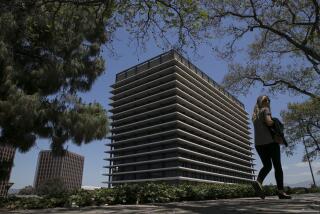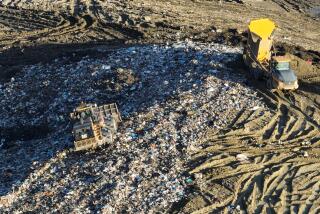‘Green Power’ Campaign by DWP Wilts
Nearly four years after Los Angeles launched a “Green Power” program promising residents a shift to clean, renewable energy sources, the city has increased the amount of clean energy it generates by less than half a percentage point and continues to rely almost entirely on coal, natural gas and nuclear power.
The Los Angeles Department of Water and Power launched the program in May 1999 with a multimillion-dollar marketing campaign featuring Hollywood celebrities and leading environmentalists.
If customers agreed to pay a power premium -- about $3 extra a month for the average homeowner, thousands of whom have signed up for the program -- the city would use the money to develop renewable energy sources such as wind, solar and geothermal plants and to buy green power from other utilities.
But many city officials and environmentalists are unhappy with the progress of the DWP effort, which has cost $40 million while producing only a small number of solar panels and a facility that generates a meager amount of electricity from landfill gas. At the same time, records show that the DWP spent three times more money on marketing and administration than on buying green power from other utilities.
“It is disappointing that the Los Angeles Department of Water and Power has not fulfilled its promise of four years ago,” said consumer advocate Ralph Nader, who helped kick off the Green Power campaign.
The California Public Interest Research Group recently labeled the DWP “the dirtiest municipal utility west of the Mississippi.”
Amid growing dissatisfaction with the DWP’s progress, Mayor James K. Hahn plans to join agency officials Monday to announce a $162-million investment in a wind-power facility 12 miles north of Mojave that will provide enough electricity to power 120,000 homes when completed in July 2004.
“LADWP currently buys almost all of its renewable power, but with the completion of Pine Tree project next year, we will go from being a consumer to being a generator,” Hahn said.
The DWP generates 2.2% of its electricity from renewable, green sources, up from 1.8% in 1999. Los Angeles officials say they hope eventually that the city will generate 20% of its power from renewable sources; statewide, utilities generate an average of 12% from those sources, according to a recent study of the DWP green program by CalPIRG.
DWP General Manager David Wiggs Jr., who took over the agency in May 2001, acknowledges shortcomings in the program and has formed a committee of department administrators to boost green power generated by the utility in or close to the Los Angeles Basin. He admits that the program so far has failed to fully live up to its marketing slogan: “Green Power for a Green L.A.”
Wiggs said he is especially concerned that the DWP has not lived up to its marketing campaign, which suggested that clean energy sources would be developed in the Los Angeles area to reduce the need for electricity from polluting power plants and therefore lead to cleaner local air.
The energy produced by the proposed wind farm is expected to allow DWP to occasionally reduce the use of gas-fired plants in the basin, cutting carbon dioxide emissions by 210,000 tons annually.
Those enlisted to help promote the green power program to the public included actors Ted Danson, Laura Dern and Ed Begley Jr., as well as Nader, then-Energy Secretary Bill Richardson and environmental groups including the Coalition for Clean Air.
*
Backing From Nader
Nader endorsed the DWP program in 1999, saying that, unlike other public utility green power programs, the Los Angeles effort would focus on developing new “green” sources of energy instead of simply buying it from existing suppliers.
“We expect more clean power from public power than from private corporate entities,” Nader said in a recent interview. “The Los Angeles Department of Water and Power executives need to step up, and step up fast.”
Begley, an outspoken environmentalist, said he prefers to consider the successes of the program in educating the public and creating a base of support on which to build. The program, he said, “has done well to position this utility to further integrate renewable resources into its portfolio.” The stakes are high because the DWP is the largest public utility in the country, and its more than 1 million residential and commercial customers create 10% of California’s demand for electricity.
From the inception of the DWP program in May 1999 until Jan. 1, 2002, the agency had “not yet produced any renewable energy in the Los Angeles Basin,” according to an audit conducted by the city controller’s office and released in February.
In late 2002 the city started operating one new project that uses 50 microturbines to produce power by burning methane gas from the closed Lopez Canyon Landfill. That project produces 1.5 megawatts, enough to power 1,500 homes. It cost $3.9 million.
The department spent $22.7 million more developing solar projects, “but has not produced significant amounts of green power,” according to the city audit.
Meantime, the agency is in the process of building two gas-fired electricity plants in the Los Angeles Basin to replace two older ones and is considering whether to invest in a proposed coal-fired plant in Utah.
“We feel that is absolutely the opposite direction from where the DWP should be going right now,” said Eli Richlin, coauthor of the CalPIRG report.
Tim Carmichael, executive director of the Coalition for Clean Air, objected to what he sees as the DWP’s resistance to phasing out fossil fuels.
“We had suggested that they not only should be investing in renewable energy, but they should be divesting from their existing fossil fuel plants. We believe [DWP’s current course] is counterproductive and contradictory and certainly not consistent with the way the agency portrays itself on the environment.”
Environmentalists were particularly disappointed that the city last year sold only half of its share in the massive coal-burning Mohave Generating Station in Nevada.
Los Angeles draws 50% of its power from coal plants, 25% from natural gas and 12% from nuclear power. Another 11% comes from large hydroelectric plants, which are not considered green power because of the damage large dams cause to the environment, Richlin said.
The remainder comes from green power, most of which is bought from wind power facilities in Oregon, Washington and Wyoming.
Overall, Los Angeles produces about 80% of its energy needs.
Wiggs said the two new natural-gas power generators planned for Los Angeles will be cleaner and more efficient than the plants they are replacing.
*
All-Green Impractical?
The idea of phasing out most of the fossil-fuel plants in favor of green power is not practical, Wiggs said.
“It is unrealistic in my lifetime,” he said. “We rely on the coal plants. They are what kept the lights on and rates down during the state energy crisis.”
Nonetheless, Wiggs is under pressure to come up with an aggressive plan to build renewable energy sources.
Environmentalists are pressing the DWP to comply with a state rule that requires private utilities to generate 20% of their energy from renewable sources by 2017.
Mayor Hahn has asked Wiggs to come up with options for making sure at least 20% of the utility’s total electrical generation comes from a combination of renewable power and emission-reducing programs.
“I support trying to do that,” Wiggs said of Hahn’s goal, but he added that he’s not sure even that can be achieved by 2017.
Wiggs said any change would have to be done in a way that does not jeopardize the reliability of the electricity system and does not dramatically drive up power rates.
City Council members also are pushing for action.
The city made $90 million from the sale of half of its interest in the Mohave plant, and some officials, including Council President Alex Padilla, want all of that money to go into developing renewable energy.
In addition to investing in new plants, the Green Power campaign promised to use customers’ electricity premiums to buy more green power from other private operators. During the first three years of the program, however, the utility spent $2.6 million buying green power and so-called Green Tickets -- which are credits for investing in clean energy -- while spending $2 million on administration and $5.3 million on marketing, according to the city audit.
The DWP had to subsidize the program from other budgets because the premium paid by customers generated only $3.3 million during the three years that were audited.
*
Marketing Costs
“Although the demand for renewable energy in the Green Power program has grown over the period of the audit, the department has spent a disproportionate amount of money on marketing and promotion,” said the audit, conducted for the city controller by the Barrington-Wellesley Group. The demand was measured by the number of customers who signed up each year to pay the premium.
The agency, however, appears to have exaggerated even that success. The audit found that the DWP claimed it had signed up 90,000 Green Power customers, but auditors could verify only 75,000. In addition, the vast majority of those signed up for Green Power were not charged for membership because they are low-income customers.
The City Council has called for reforms in the ways in which the program is tracked and results are publicly disclosed.
Councilman Eric Garcetti said the ratepayers who are shelling out extra money each month deserve more from the DWP.
“The ratepayers who have shown their commitment to the environment by signing up in record numbers need a much bigger payoff from this program where they live,” Garcetti said.
More to Read
Inside the business of entertainment
The Wide Shot brings you news, analysis and insights on everything from streaming wars to production — and what it all means for the future.
You may occasionally receive promotional content from the Los Angeles Times.











